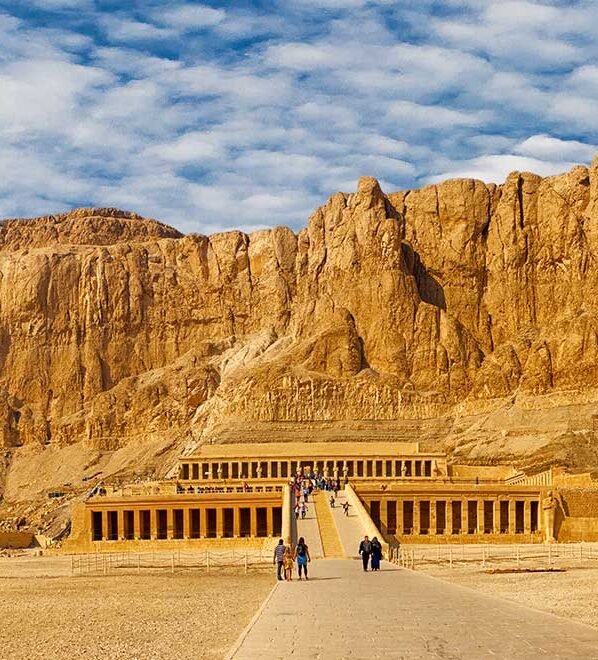The Temple of Hatshepsut at Deir al-Bahari is a masterpiece of ancient Egyptian architecture, a stunning and unique mortuary temple that stands as a powerful testament to the reign of the remarkable female pharaoh Hatshepsut (circa 1479-1458 BC). Unlike the traditional pylon-and-courtyard design of many New Kingdom temples, Hatshepsut's temple boasts a distinctive terraced structure, blending harmoniously with the dramatic natural amphitheater of the towering limestone cliffs behind it.
Here's a description highlighting its key features:
- Unique Terraced Design: The temple rises in three majestic levels, connected by long, impressive ramps that ascend towards the cliff face. This innovative design, possibly inspired by the earlier mortuary temple of Mentuhotep II located nearby, creates a sense of grandeur and integration with the landscape.
- Harmonious Integration with Nature: The temple's limestone construction and terraced layout seem to emerge organically from the surrounding cliffs, creating a visually breathtaking spectacle. This deliberate architectural choice emphasizes the connection between the pharaoh, the divine, and the natural world.
- Exquisite Reliefs and Decorations: The walls of Hatshepsut's temple are adorned with intricate and remarkably well-preserved painted reliefs that narrate significant aspects of her reign and divine legitimacy. Key scenes include:
- The Divine Birth of Hatshepsut: Depicting her conception by the god Amun, legitimizing her claim to the pharaonic throne.
- The Expedition to the Land of Punt: A detailed pictorial record of a significant trade mission, showcasing exotic goods, animals, and the people of Punt (possibly modern-day Somalia or the Arabian Peninsula). This is one of the earliest and most comprehensive depictions of a trade expedition in ancient Egyptian art.
- The Transportation of Obelisks: Illustrating the quarrying, transportation, and erection of obelisks at the Karnak Temple, highlighting Hatshepsut's ambitious building projects.
- Religious Rituals and Offerings: Scenes of Hatshepsut and other deities engaged in various religious ceremonies.
- Chapels Dedicated to Deities: The temple incorporates several chapels dedicated to important gods, including:
- The Sanctuary of Amun: Located at the innermost part of the third terrace, it was the most sacred area of the temple.
- The Chapel of Hathor: Featuring distinctive Hathor-headed columns and reliefs depicting the goddess as a cow nurturing Hatshepsut.
- The Chapel of Anubis: Dedicated to the jackal-headed god of mummification.
- Colonnades and Porticoes: Each terrace features elegant colonnades with square pillars or rounded columns, providing shade and architectural rhythm. The upper terrace's portico was once adorned with impressive Osiride statues of Hatshepsut.
- The Sanctuary: Hewn directly into the rock of the cliff face, the sanctuary at the uppermost level housed the cult statue of Amun.
- Historical Significance: The temple served not only as a place for Hatshepsut's mortuary cult and offerings to the gods but also as a powerful visual statement of her authority and achievements as pharaoh.
Despite later attempts by her successor, Thutmose III, to erase her memory by defacing her images and inscriptions, Hatshepsut's temple at Deir al-Bahari remains a breathtaking and unforgettable monument, showcasing exceptional architectural innovation, artistic skill, and the enduring legacy of a remarkable female ruler. Its dramatic setting and intricate decorations make it a highlight for any visitor to Luxor.


